
Hodgson's bat, also called the copper-winged bat or black-and-orange myotis, is a species of vesper bat in the genus Myotis, the mouse-eared bats. Favouring mountain forests, it is found throughout Central, Southeast, and East Asia, from Afghanistan to Taiwan. It is about 5 centimetres (2.0 in) long and is distinguished from most other species of bat in this range by its yellowish colouration.

The African yellow bat is a species of bat in the family Vespertilionidae, the vesper bats. Other common names include African yellow house bat, yellow-bellied house bat, and Dingan's Bat. It is one of fifteen species in the genus Scotophilus.

The lesser Asiatic yellow bat is a species of vesper bat. It is found in Bangladesh, Cambodia, India, Indonesia, Malaysia, Pakistan, the Philippines, Sri Lanka, and Taiwan.
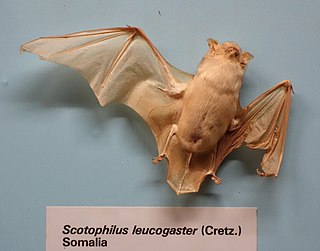
The white-bellied yellow bat or white-bellied house bat, is a species of vesper bat in the genus Scotophilus, the house bats. It can be found in Angola, Benin, Botswana, Burkina Faso, Cameroon, Central African Republic, Chad, Ivory Coast, Gambia, Ghana, Guinea, Guinea-Bissau, Kenya, Mali, Mauritania, Namibia, Niger, Nigeria, Senegal, Sierra Leone, Sudan, Togo, Uganda, and Zambia. It is found in dry and moist savanna and open woodland. It is a common species with a very wide range, and the International Union for Conservation of Nature has assessed its conservation status as being of "least concern".
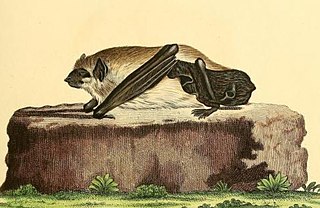
Schreber's yellow bat or the giant house bat, is a species of vesper bat. It is found in Benin, Democratic Republic of the Congo, Ivory Coast, Ghana, Kenya, Malawi, Mozambique, Nigeria, Senegal, Tanzania, Togo, and Zimbabwe. Its natural habitats are subtropical or tropical moist lowland forests, dry savanna, and moist savanna. It is an uncommon species and its biology is poorly known. It was first described in 1774 by the German naturalist Johann Christian Daniel von Schreber, who named it Vespertilio nigrita. It was later transferred to the genus Scotophilus, making it Scotophilus nigrita.

The easterngreenish yellow bat is a species of vesper bat. It is found in Botswana, Central African Republic, Eswatini, Ethiopia, Kenya, Malawi, Mozambique, South Africa, Tanzania, Zambia, and Zimbabwe. Its natural habitats are dry and moist savanna.

Hildegarde's tomb bat is a species of sac-winged bat in the family Emballonuridae. It is found near the coast in Kenya and Tanzania where it feeds in tropical dry forests and roosts in caves. It is a diurnal species and the International Union for Conservation of Nature has assessed its conservation status as "endangered". The specific name hildegardeae was given in honour of anthropologist Hildegarde Beatrice Hinde.
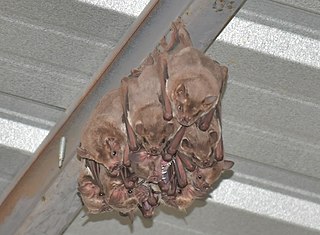
The fraternal fruit-eating bat is a species of bat in the family Phyllostomidae that is found in drier habitats in Ecuador and Peru. It was formerly considered to be a subspecies of the Jamaican fruit bat, but was raised to species level in 1978. The smallest species in the group of large Artibeus, it has a forearm length of 52–59 mm (2.0–2.3 in), a total length of 64–76 mm (2.5–3.0 in), and a weight of 30–55 g (1.1–1.9 oz).
The gland-tailed free-tailed bat is a species of bat in the family Molossidae. Its natural habitats are subtropical or tropical moist montane forests, dry savanna, and caves.

Davis's round-eared bat is a species of bat in the family Phyllostomidae. It is found in Belize, Guatemala, Honduras, and southeastern Mexico.
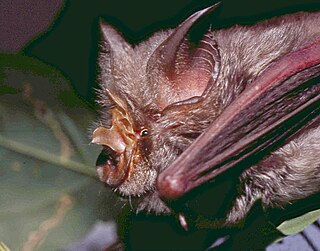
Rüppell's horseshoe bat is a species of bat in the family Rhinolophidae found in Africa. Its natural habitats are subtropical or tropical dry forests, savanna, caves and other subterranean habitats. This species is quite common in parts of its range, and no specific threats have been recognised, so the International Union for Conservation of Nature has rated its conservation status as being of "least concern".

Scotophilus is a genus of vespertilionid bats commonly called yellow bats. They are found in southern Asia and Africa. They are the only members of the tribe Scotophilini.

The greater monkey-faced bat or greater flying monkey is a megabat endemic to Solomon Islands, Bougainville, in Papua New Guinea, and nearby small islands. It is listed as a critically endangered species and the population is decreasing. It is the largest monkey-faced bat.
Chaerephon atsinanana is a free-tailed bat found on Madagascar. It was considered a subspecies of the little free-tailed bat until 2010. During the day, they are known to roost in man-made structures such as the roofs or attics of buildings.

Andrew Rebori's house bat is a species of bat found in Africa.

Ejeta's yellow bat or Ejeta's house bat is a species of vesper bat endemic to in Ethiopia. It was described as a new species of bat in 2014.
Livingstone's yellow bat or Livingstone's house bat is a species of bat found in Africa.
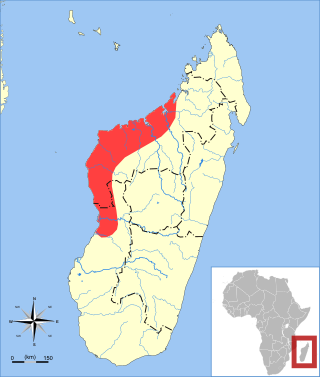
The Marovaza yellow bat or Marovaza house bat is a species of bat found in Madagascar.

The Malagasy yellow bat, sometimes known as the western yellow bat, is a species of vesper bat endemic to Madagascar.
















